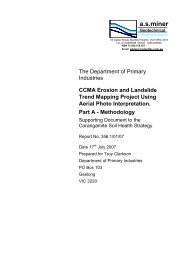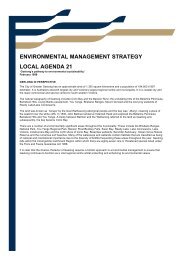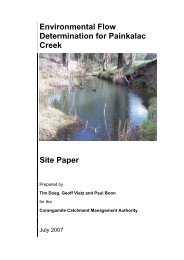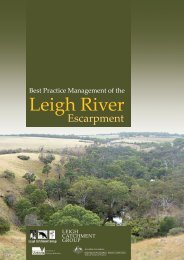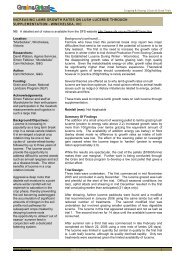Optimal Plant Density And The Effect Of Grazing On Grain Yield Of ...
Optimal Plant Density And The Effect Of Grazing On Grain Yield Of ...
Optimal Plant Density And The Effect Of Grazing On Grain Yield Of ...
Create successful ePaper yourself
Turn your PDF publications into a flip-book with our unique Google optimized e-Paper software.
Cropping & <strong>Grazing</strong> | <strong>Grain</strong> & Graze Trials<br />
<strong>Optimal</strong> <strong>Plant</strong> <strong>Density</strong> <strong>And</strong> <strong>The</strong> <strong>Effect</strong> <strong>Of</strong> <strong>Grazing</strong> <strong>On</strong> <strong>Grain</strong> <strong>Yield</strong> <strong>Of</strong> Early Sown<br />
Wheat - Epping Forest, Tas<br />
Location:<br />
"Fairfield", Epping Forest, Tasmania<br />
Funding Organization: <strong>Grain</strong> and Graze<br />
Researchers:<br />
Geoff Dean and Brett Davey, SFS/TIAR<br />
Simon Munford, DPIW<br />
Author: Geoff Dean<br />
Acknowledgments: Tom and Philip Osborne<br />
Growing season rainfall (Mar‐Nov):<br />
369 mm including irrigation<br />
Summary of Findings:<br />
<strong>The</strong>re was no significant difference in the grain yield from cut and uncut early sown Mackellar wheat and May<br />
sown wheat, all sown at 200 plants/m 2 . Early sown uncut wheat at a density of 50 plants/m 2 yielded<br />
significantly lower than 125 and 200 plants/m 2 .<br />
With lower plant densities and cutting treatments imposed, there were less tillers and ears/m 2 , however this<br />
resulted in reduced soil water usage and more moisture being available for grain fill. <strong>Plant</strong> height was<br />
significantly greater with the highest plant density in early sown wheat and the incidence of lodging was<br />
significantly greater for this treatment.<br />
Background:<br />
Studies on the effect of grazing on grain yield have<br />
compared plots sown at the same time. However<br />
grain yield from an early sowing may be lower than<br />
from a “traditional” May sowing as most Australian<br />
varieties have not been selected for a March or<br />
earlier sowing and are more prone to disease and<br />
lodging. It is therefore important to also compare<br />
yields of an early sown with a May sowing.<br />
In the UK, planting dates for grain‐only wheat crops<br />
have progressively shifted back to September ie<br />
comparable with March in Australia. This enables<br />
development of a strong vigorous plant entering<br />
winter and has the added advantage of removing<br />
moisture from the soil profile in Tasmania (a benefit<br />
in most years!). Lower plant densities are recognised<br />
as essential to reduce the canopy size and minimise<br />
leaf disease and lodging.<br />
Method:<br />
Variety: Mackellar<br />
Treatments:<br />
March sown:<br />
May sown: 200 plants/m 2<br />
normal density – 200 plants/m 2 (approx 90 kg/ha)<br />
reduced – 125 plants/m 2<br />
UK early sowing – 50 plants/m 2<br />
Grazed (cut)<br />
In Tasmania these potential problems can be reduced<br />
through canopy management by grazing, but given<br />
the high grain yields overseas it would be informative<br />
to evaluate early sowing of a grain‐only wheat crop.<br />
<strong>The</strong>re is potential for early sowing in Tasmania where<br />
the crop can be watered up in a dry summer/autumn.<br />
<strong>The</strong> major limiting factors will be excess vegetative<br />
growth and greater disease pressure due to the<br />
longer growing season.<br />
<strong>The</strong> objective of this study was to compare grain<br />
yields of early sown wheat with grazed (cut) wheat<br />
sown at the same time and that sown at a more<br />
traditional time, May.<br />
A further aim was to compare a commercial plant<br />
density for dual purpose and grain‐only production<br />
with reduced rates comparable to that used for early<br />
sowing in the UK.<br />
www.sfs.org.au 2007 Growing Season Results 1
Cropping & <strong>Grazing</strong> | <strong>Grain</strong> & Graze Trials<br />
<strong>The</strong> trial was sown under a centre pivot and there were four replicates in a randomised complete block design<br />
with buffer plots to separate the different sowing dates. <strong>The</strong> earlier sowing date was on 12 th April and that of the<br />
“traditional” treatment, 25 th May. <strong>The</strong> trial was sown with 9:13:17:4 fertiliser at 250kg/ha and followed a tickbean<br />
crop.<br />
Nitrogen (50kgN/ha) was top‐dressed on 6 th September and a further 50kgN applied to plots on 19 th October and<br />
watered in. To cover the range of growth stages, three fungicides were applied. Soil moisture cores were taken<br />
after flowering to measure available water during grain fill.<br />
<strong>The</strong> “grazed” plots were cut on 28th August at GS30‐31. Prior to grain harvest, samples were hand harvested to<br />
compare yield components. <strong>Grain</strong> from the rest of each plot was harvested by machine on 15 th January 2008.<br />
Results and Discussion:<br />
Growth and dry matter:<br />
With irrigation, establishment was reasonable but the higher densities for both sowing dates were around 20%<br />
lower than the target. <strong>The</strong> low density plots at 50 plants/m 2 looked very sparse early in the season but by<br />
September had tillered well and largely caught up. In contrast the highest density plots grew well during early<br />
tillering but later in the season the high population of tillers/ears were more prone to lodging. Diseases were<br />
adequately controlled but more evident in the early sown ungrazed plots.<br />
<strong>Grain</strong> yield:<br />
Both cutting and later sowing had no significant effects on grain yield compared with the early sown uncut<br />
treatments at 200 plants/m 2 . <strong>The</strong>re were significantly lower yields in the early sown 50 plants/m 2 treatment.<br />
<strong>The</strong>re was no significant difference between the 125 and 200 plant/m 2 densities but this is the third season where<br />
there has been a trend towards increased yield in early sown wheat with density increasing from 125 to 200<br />
plants/m 2 .<br />
Table 1: <strong>Effect</strong> of cutting and sowing date and varying plant density of early sown wheat (Mackellar) on grain<br />
yield and yield components, Epping Forest, 2007‐08.<br />
Sowing date/cut<br />
treatment<br />
<strong>Density</strong><br />
<strong>Yield</strong><br />
(t/ha)<br />
<strong>Plant</strong> ht<br />
(cm)<br />
Lodging<br />
(%)<br />
Soil moisture<br />
content (%)<br />
April/uncut 200/m 2 8.14 87.5 33.8 12.6<br />
April/uncut 125/m 2 7.99 84.8 4.8<br />
April/uncut 50/m 2 7.17 80.7 1.8 15.1<br />
April/cut 200/m 2 8.14 71.8 0.3 15.0<br />
May /uncut 200/m 2 8.37 81.8 1.3 12.8<br />
F prob. 0.008
Cropping & <strong>Grazing</strong> | <strong>Grain</strong> & Graze Trials<br />
Data on yield components is still being processed but<br />
preliminary examination shows that the number of<br />
ears/m 2 was significantly higher for both the May<br />
sown and the uncut early sown at 200 plants/m 2<br />
treatments. Cutting significantly reduced the number<br />
of ears/m 2 and the 125 and 50 plants/m 2 treatments<br />
did not fully compensate for the low initial plant<br />
densities. <strong>The</strong> number of ears/plant were however<br />
significantly higher for these densities.<br />
<strong>The</strong> soil moisture data in Table 1 shows that although<br />
cutting and lower plant density both reduced the<br />
number of tillers/m 2 this resulted in significantly<br />
higher soil moisture content and more available<br />
water for grain fill.<br />
<strong>Plant</strong> height measurements at maturity correlate<br />
broadly with ear numbers, with progressive and<br />
significant decreases in plant height with decreasing<br />
plant density (Table 1).<br />
Cutting and the later sowing also resulted in lower<br />
plant heights. Not surprisingly plant height also<br />
correlated with the extent of lodging. In particular,<br />
the visually thinner stems at the highest density of<br />
the earlier sowing resulted in significantly more<br />
lodging.<br />
Application of plant growth regulators (PGR) will<br />
reduce the incidence of lodging and a new product<br />
was evaluated at the Fairfield site on early sown<br />
uncut wheat. <strong>The</strong>re were however no consistent yield<br />
differences. Similarly, with a PGR trial conducted at<br />
Hagley in 2007‐08 on Brennan wheat, there were no<br />
significant yield increases after application with<br />
Moddus, Cycocel and a combination of the two<br />
compared with untreated plots. This is in contrast to<br />
trials conducted 5 years ago where there a yield gain<br />
from application of Moddus.<br />
www.sfs.org.au 2007 Growing Season Results 3







